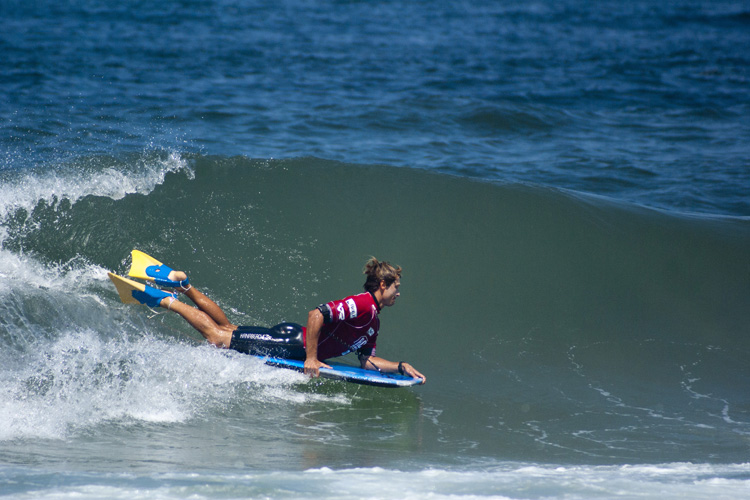Swim fins aren't always the most practical thing to use. We need time to get acquainted with the flippers because they interfere with almost everything related to bodyboarding.
When you're walking down the beach, entering the water, or performing maneuvers in the waves, you sometimes wish you hadn't swim fins.
And for beginners, it can be a bit tricky in the first sessions.
However, bodyboarders need to learn how and when to use them in different bodyboarding moments.
One thing is certain, though: you won't become an accomplished rider without fins.
There are basically four stages in which flippers play a critical (and favorable) role: paddling, duck diving, catching waves, and riding/trimming the roller.
Paddling
The first question is: how should we combine arms and swim fins when paddling on a bodyboard?
If the surf is quiet, you can just use your arms and leave your fins out of the water.
It is simple and straightforward.
But if you need to get out the back fast, you must position your chest a few centimeters back from your regular stance and then simultaneously paddle with both your arms and feet.
The board might swing a bit, but that's fine.
Ultimately, you can only kick your fins and use your leg power to glide across the water.
In this case, grab the nose of your bodyboard with both hands and let your flippers do the work.
Duck Diving
Many riders don't use their bodyboarding fins in the duck diving process. But they're really helpful, especially when swimming under the whitewater rumble.
So, what should you do at this stage? How can swim fins help bodyboarders duck dive?
Make sure you always kick your fins well underwater to get maximum propulsion.
When you approach the incoming whitewater, push the nose of the board under the water.
As you get deep under the roller, kick your fins to maximize your forward movement and emerge on the back of the wave.
Catching Waves
Another frequent question: how should we kick our feet and fins when catching a wave? When you spot a beautiful ripple, you should, once again, combine arms and feet.
But this time, lower your head and use the chest to keep the board flat on the water. As you turn your paddling power on, you'll notice how quickly you'll get in the wave.
Riding/Trimming the Wave
Right. We've now learned that swim fins provide extra thrust. However, in bodyboarding, they can also be used as a rudder or brake.
So, how should we adjust our flippers when riding a wave? And when should we keep our feet out of the water?
After looking down the line and focusing on the direction you're going, you'll be able to analyze how the wave is breaking.
At that point - do you need to apply the brakes, or do you need to steer the board quickly toward the lip?
If you need speed, you don't need friction. That is why bodyboarders always leave their feet out of the water while riding/trimming a wave.
Obviously, if you're in the barrel and you need to control momentum, you let your inside fin manage speed;
If you're riding too fast towards the shoulder of the wave, or if the wave is too steep, you should let your fins slow you down by keeping one or two legs in the water.
A fin can emulate a steering wheel or a brake.
Nevertheless, and as a general rule of thumb, a surf line is traditionally drawn without drag or loss of speed, i.e., with swim fins out of the water.
Discover the best bodyboard fins in the world.
